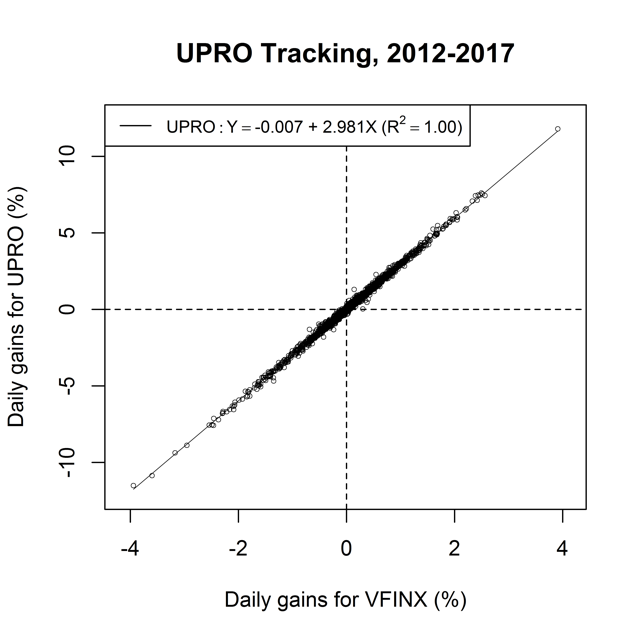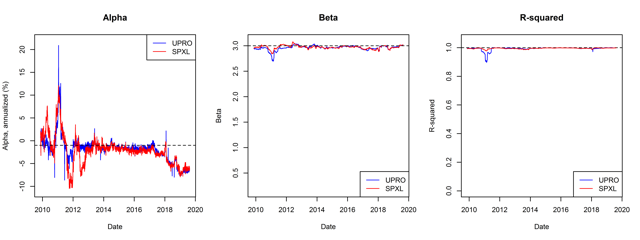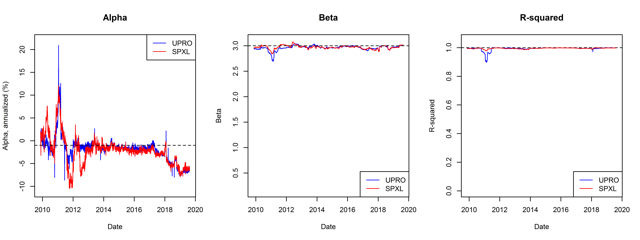[ad_1]
Background
Leveraged ETFs aim to multiple the gains of an underlying index by a fixed factor. These funds have only been around for about a decade, but they’ve demonstrated a remarkable ability to achieve their stated objective. For example, if you plot daily gains for the ProShares UltraPro S&P500 (UPRO) vs. the Vanguard 500 Index Fund Investor Shares (VFINX), you see nearly perfect 3x amplification.

A perfect 3x ETF with no expense ratio and no tracking error would have alpha = 0, beta = 3, and R-squared = 1, and here we see UPRO operating pretty close to that. In practice, we should always expect a slightly negative alpha stemming from the expense ratio, and an R-squared slightly less than 1 due to imperfect tracking (it’s 0.996 here, which rounds to 1.00).
Alpha is key for leveraged ETFs
Knowing that leveraged ETFs aim to amplify daily gains, it’s tempting to use beta and R-squared to evaluate performance. These metrics are important, but if you don’t also look at alpha, you can get yourself into big trouble.
To illustrate, we saw above that UPRO had a daily alpha of -0.007%. This corresponds to an annual loss of about 1.7%, which is somewhat higher than we’d expect given UPRO’s expense ratio of 0.92%. Depending on what you’re looking to do with a 3x S&P ETF, an alpha of -0.007% might be manageable. But if UPRO’s alpha was, say, -0.02% instead of -0.007%, you’d be looking at a 4.9% annual loss. I suspect that would render most leveraged-based strategies ineffective (including this one of mine).
Declining alpha for UPRO and SPXL
Unfortunately, UPRO’s alpha has, in fact, declined severely over the past year or two, while its beta and R-squared held steady. This is also true for one of its main competitors, the Direxion Daily S&P 500 Bull 3x Shares ETF (SPXL) (Table 1).
Table 1. Performance metrics for UPRO and SPXL, stratified by time period. 2018-present goes through August 16, 2019.
| Alpha | Beta | R-squared | |
| 2012-2017 | |||
| UPRO | -0.0067 | 2.981 | 0.996 |
| SPXL | -0.0088 | 2.978 | 0.995 |
| 2018-present | |||
| UPRO | -0.0255 | 2.986 | 0.997 |
| SPXL | -0.0252 | 2.984 | 0.998 |
The more recent alphas are several times larger in magnitude than the 2012-2017 ones. On an annualized basis, UPRO’s alpha went from -1.7% to -6.2%; SPXL’s went from -2.2% to -6.1%.
For a more detailed look at when and how these metrics changed, we can plot them over time using a 100-day moving window:

Looking first at beta and R-squared, we see steady performance near the target values, with occasional deviations that appear to be slightly larger for UPRO.
Looking at alpha, we see wide fluctuations at the beginning, followed by a stable period with values hovering around -1% (UPRO’s expense ratio is 0.92%, SPXL’s is 1.02%). Starting in 2017, their alphas sharply declined, bottoming out around -8% and recovering slightly to -6%.
Related to volume?
My guess is that the worsening alpha of these ETFs is related to decreasing trading volume. Looking at data from Nasdaq, trading volumes have pretty steadily decreased for both funds, and are currently <10% of historical maximums.
This is not volatility decay
Readers might wonder whether this problem is related to volatility decay, which refers to path-dependent losses that affect leveraged ETFs. There are lots of articles on the subject here on Seeking Alpha, but the basic idea is that a sequence of amplified gains has a different net result than a single amplified gain over the same time period.
The alpha problem here is distinct from volatility decay. To see this, note that an ideal 3x S&P ETF would have alpha = 0 and beta = 3, despite being fully susceptible to volatility decay (e.g., its net gain over 6 months differs from 3x the net gain of the S&P).
Conclusions
Leveraged ETFs are a valuable tool for portfolio construction. Unfortunately, the recent alphas for UPRO and SPXL – which can be interpreted as their effective expense ratios – are prohibitively large in magnitude. This likely disqualifies many leverage-based strategies that would be profitable otherwise.
Disclosure: I am/we are long UPRO. I wrote this article myself, and it expresses my own opinions. I am not receiving compensation for it (other than from Seeking Alpha). I have no business relationship with any company whose stock is mentioned in this article.
Additional disclosure: The author used Yahoo Finance to obtain historical stock prices and used R (including the “quantmod” and “stocks”, and packages) to analyze the data and generate figures.
[ad_2]
Source link Google News

